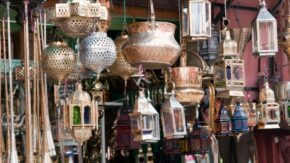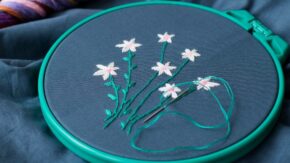There are 13 main types of crafts, each requiring a unique set of skills and materials. Some of the major categories of crafts include ceramics craft, textile craft, paper crafts, meta craft, woodcraft, leathercraft and needlework. Crafts are everywhere, from the cozy quilt on your bed to the handmade necklace from that local market.
The term ‘crafting’ refers to a variety of enjoyable activities that involve creating items, often utilizing traditional skills passed down through generations. The objective of crafting is to produce something that is both functional and aesthetically pleasing.
Crafting has lots of benefits such as reduced stress levels better mood and improved mental health. In addition, getting creative can boost your brain power and your manual dexterity, which is excellent for both seniors and young kids.
At the heart of it, crafting is all about making cool stuff with your own two hands. Some do it for fun, some for tradition, and some to simply try something new. It’s amazing how a piece of yarn or a lump of clay can turn into something awesome. So, let’s dive in and chat about the wild and wonderful world of crafts. Ready? Cool, let’s go!
What Are The Different Types of Crafts?
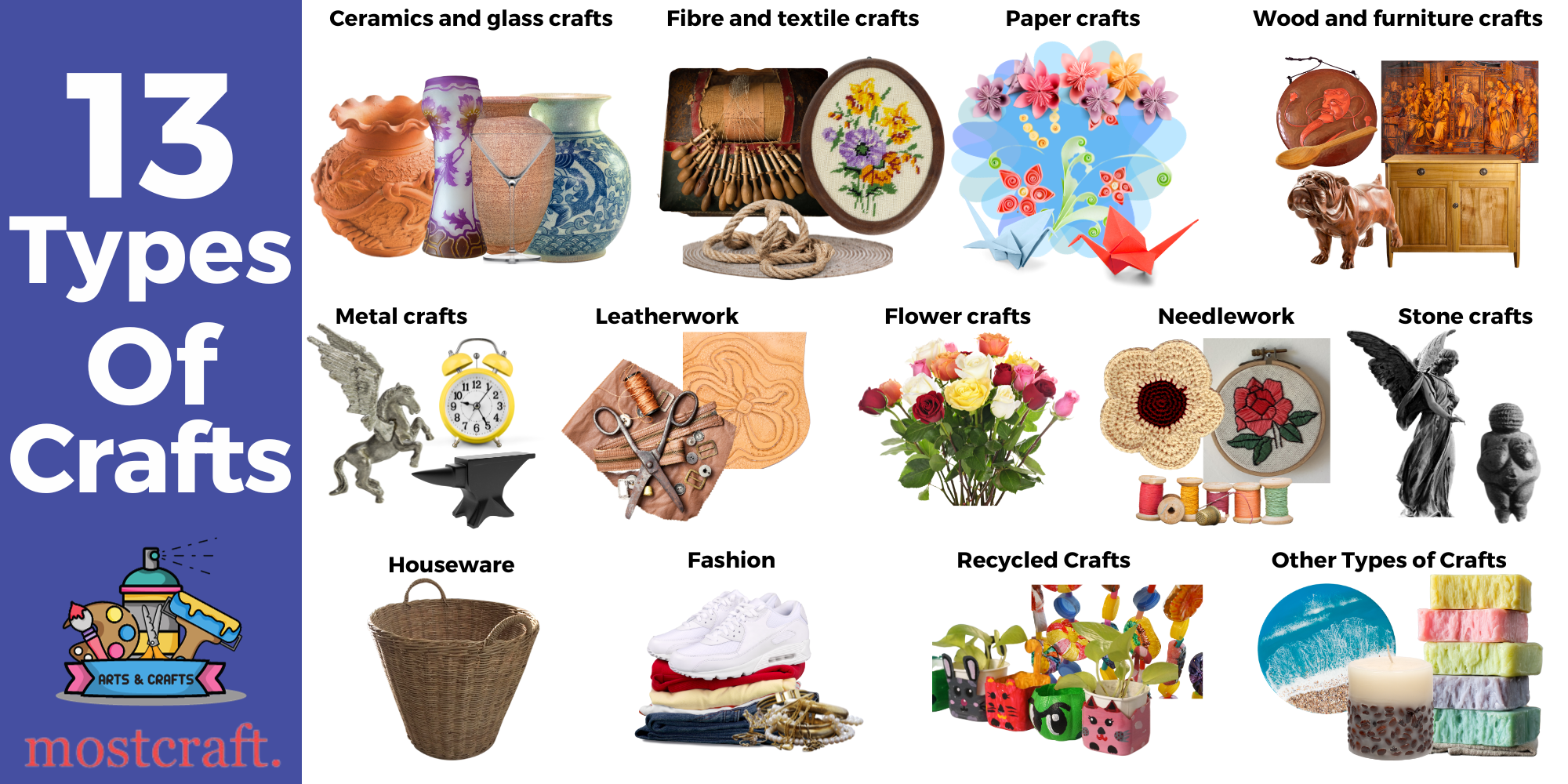
The different types of painting techniques and painting methods are incredibly varied, so you’ll always have a fresh source of inspiration, and your new hobby will never get boring!
Ceramics And Glass Crafts
Ceramics and glass crafts are a very broad category that uses ceramic and glass materials to create functional household items as well as decorative pieces that can look great in your home and make wonderful gifts for friends and family.
Azulejo
Azulejos are a type of ceramic tile that has been a significant feature of Portuguese and Spanish architecture for hundreds of years. Their trademark blue and white colors make these tiles instantly recognizable, although you can choose to make them in many different colors and designs.
Azulejos are often seen used as decorative wall tiles in old churches and palaces in Portugal and Spain, as well as on home kitchen and bathroom walls and even flooring.
Cameo Glass
Cameo glass dates back to ancient Roman times. It involves engraving or etching and carving through fused layers of differently colored glass to produce designs that typically feature white opaque glass figures on a dark-colored background.
Originally, this form of glass art was used as a cheaper alternative to the more expensive vessels engraved with natural layers of semi-precious stones like agate and onyx. Using glass enabled those original crafters to create predictable and consistent colored layers, even for round objects.
Cameo glass is typically used to create scenes or portraits on decorative bowls and ornate glass lamps.
Earthenware
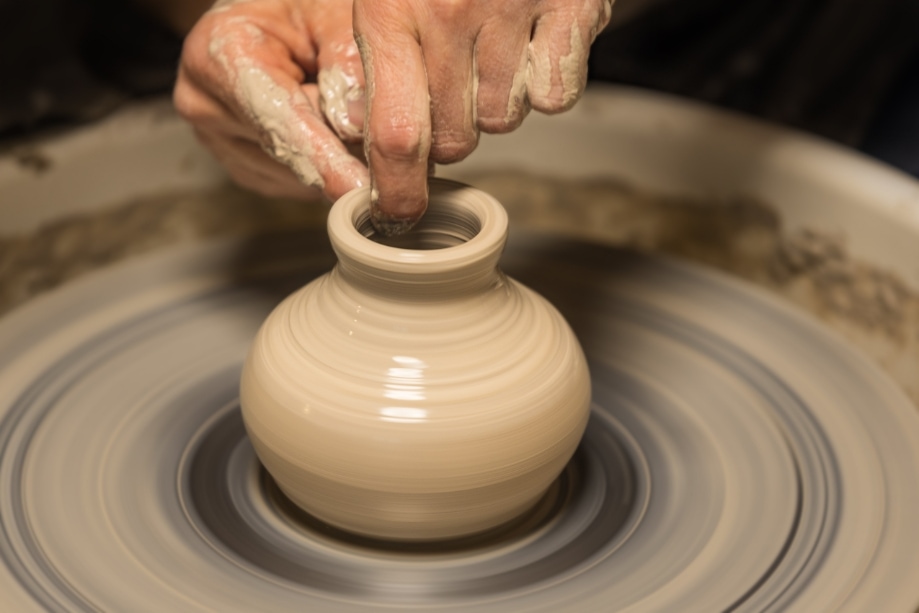
Earthenware is a type of clay pottery that’s fired at low temperatures between 1,000 and 1,150 degrees. The result is a hard, brittle, slightly porous material, which cannot be used to contain water or other liquids unless it’s glazed to make it waterproof.
Examples of earthenware include terracotta pots, decorative plates, and mugs.
Glass And Glass Art
Glass art and glass are terms that refer primarily to decorative objects made from glass that are designed for display rather than any particular function.
Examples of glass art include glass sculptures, blown glass vases, and stained glass windows.
Glassware
In contrast to glass art, glassware refers to items made from glass that you can use around your home, such as drinking glasses, bowls, and mason jars.
Mosaic
A mosaic is a pattern or image that’s created by arranging tiny pieces of colored stone, glass, or ceramic.
Mosaics first appeared in ancient Roman times when they were used to decorate the walls and floors in ancient Roman and Byzantine buildings. These days, mosaic is still used to create decorative wall hangings, table tops, and the like.
Porcelain
Porcelain first appeared in China and rapidly spread throughout East Asia, then to Europe, and eventually became popular around the world. This form of ceramic is fired at extremely high temperatures, making the material extremely hard and non-porous while being delightfully fine and translucent to look at.
Examples of porcelain objects you could make include ornamental figurines, decorative vases, and fine china crockery.
Pottery
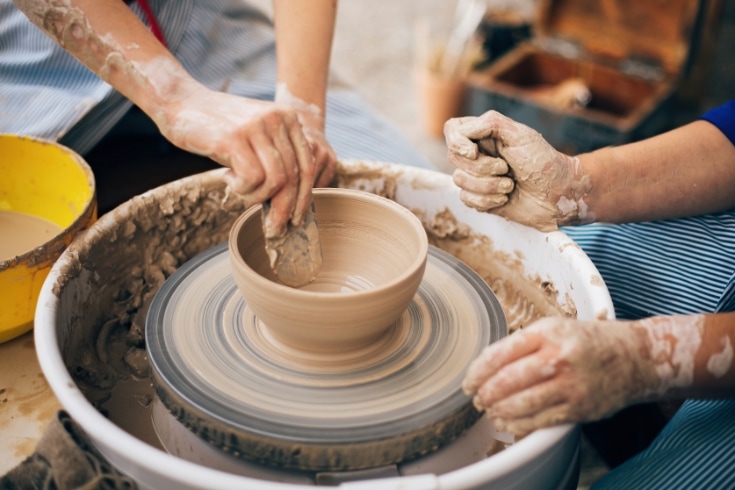
Many of you will remember the iconic potter’s wheel scene in the movie “Ghost,” which was responsible for the immediate boom in the number of people learning how to make pottery!
Pottery is something of an umbrella term used to describe the process of using natural raw materials like earthen minerals and clay combined with water and then modeling them into forms. Once the object has been created, the clay is fired in a kiln at high temperatures to harden it and make it heat-resistant and waterproof.
You can make a wide range of pottery objects, including vases, bowls, teapots, and the like.
Stoneware
Stoneware is a form of ceramic pottery that’s fired at very high temperatures and is less porous and denser than earthenware. Stoneware is typically painted or stained to create a contemporary look that’s extremely popular in kitchenware.
Thanks to its durability, stoneware is typically used to make functional items, such as baking dishes, jugs, and coffee mugs.
Fiber And Textile Crafts
Using fiber and textiles to make functional or decorative pieces has been around for centuries and remains popular with crafters today. Techniques include weaving, knotting, stitching, and rug and lace making.
Bobbin Lace
The art of creating bobbin lace dates back to 16th-century Italy and is also sometimes known as pillow lace or bone lace.
You make bobbin lace by twisting and braiding lengths of thread and winding them onto bobbins. As you go, your weaving is held in place by pins set into a lace pillow in a pattern. This form of lace-making is used to create collars, bookmarks, tablecloths, and decorative trim for items of clothing.
Felting
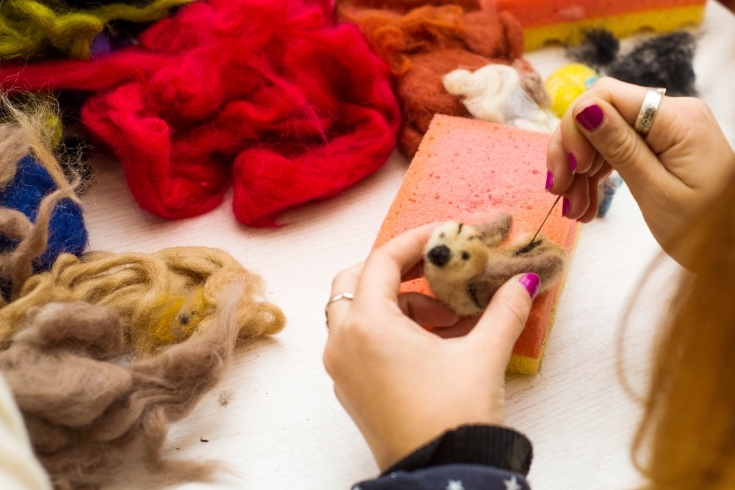
The craft of felting is a fascinating form of textile making that involves matting, condensing, and pressing fibers together, most commonly using a hot water and agitation method and needle felting, where special barbed needles are used.
You can make a huge range of pieces from felt, including hats, slippers, handbags, wall art, and toys. And I have very fond memories of finding a Fuzzy Felt kit in my Christmas stocking on Christmas morning every year!
Knotting
The craft of knotting is pretty much as it sounds in that you create a series of knots to form a decorative or functional object, most commonly intricate work such as macramé, although you can make simpler pieces using fewer knots.
This form of crafting is typically used to make wall hangings, decorative fringes, and friendship bracelets.
Rope-Making
Rope-making is the traditional craft of twisting or braiding fibers together to form a long, strong cord. Common rope-making methods often involve a rope walk, where long fiber strands are stretched and twisted together. You can make rope from natural fibers like hemp, linen, jute, coir, straw, sisal, manila hemp, and synthetic fibers like nylon and polyester.
Ropes are generally made for decorative purposes, skipping ropes, or for use on yachts and other vessels.
Rug Making
The craft of rug making refers to the art of creating rugs for use around your home. You can use many different techniques, including hand-knotting, braiding, rag rugging, and hooking.
Rugs can be functional or decorative, and examples include Persian carpets, braided oval rugs, and latch hook wall hangings.
Spinning
Spinning is the art form of turning raw natural fibers, like cotton or wool, into yarn or thread by twisting them together using a spinning wheel or spindle. The thread is then used to create clothing items or practical pieces such as throws and cushion covers for your home and embroidery thread.
Examples of what you can create by spinning include silk thread, handspun wool yarn, and art yarns with unique textures.
Stitch
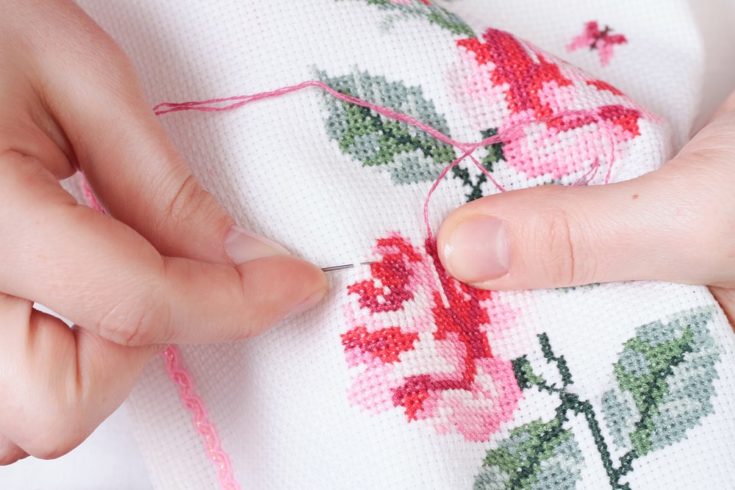
Stitching is the art of decorating or joining fabric using a needle and thread. This craft encompasses a huge range of techniques, from simple sewing to elaborate embroidery.
Examples of common pieces of stitchwork include quilts, cross-stitch samplers, and embroidered clothing.
Tatting
If you have nimble fingers and patience, the craft of tatting could be the perfect hobby for you. Tatting is a technique used to make delicate lace using a complicated series of knots and loops. This form of lacemaking is typically done using a small shuttle, although needle tatting is also common.
Examples of this craft include jewelry, decorative edgings for clothing items, and tatted doilies.
Weaving
The development of weaving and spinning first began in ancient Egypt around 3400 BC and went on to become a massive industry during the Industrial Revolution of the 18th century.
Weaving involves creating a piece of fabric by interlacing two sets of thread at right angles to each other, usually using a loom. The loom holds the vertical warp threads in place while the horizontal weft threads are woven through them.
Weavers create tapestries, table runners, handwoven scarves, and countless other clothing items and decorative pieces.
Paper Crafts
Papercrafts cover a massive range of artistic hobbies and projects that use paper as their primary material. Below, we provide brief explanations and examples of some of the most popular paper crafts you might like to try.
Bookbinding
The craft of bookbinding basically entails assembling paper sheets into a book. You can create simple stapled booklets right through to intricately stitched and leather-bound volumes, using a variety of materials, such as cloth, leather, and threads, to get the look and durability you want.
Examples of bookbinding projects you could undertake include hardcover novels, leather-bound diaries, hand-stitched poetry books, and personal journals with unique covers.
Calligraphy
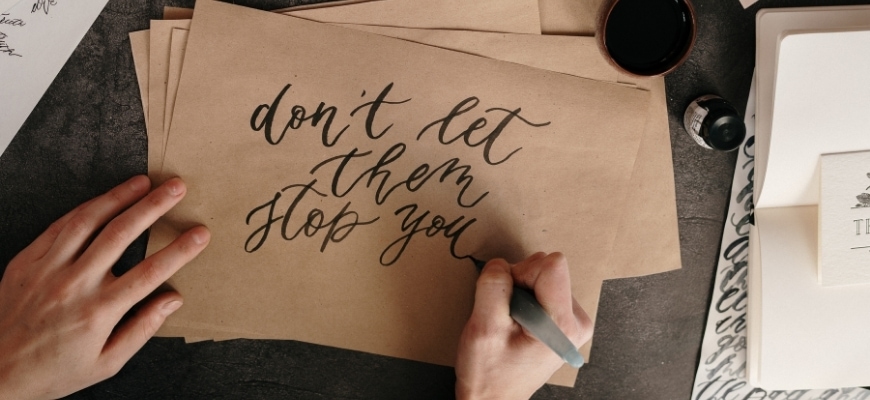
The word calligraphy is derived from the Greek words meaning ”beautiful writing,” which describes this craft pretty accurately since it involves creating expressive and harmonious lettering.
A calligrapher uses special tools like nipped pens and fine brushes to produce legible and artistic work. Typical calligraphy projects include fancy wedding invitations, historical document replicas, personalized stationery, and artfully lettered quotes for use as wall decor.
Cast Paper
The craft of cast paper art is often used in schools to inspire creativity in younger children. The technique involves transforming paper pulp, often made using recycled paper, into three-dimensional pieces of art. You press the wet pulp into special molds and allow it to dry, then use it to create detailed, textured designs that can then be painted or sealed.
Typical cast paper projects include sculpted paper flowers, bas-relief wall artworks, textured greeting cards, and decorative dishes and bowls.
Decoupage
Decoupage comes from the French word “decouper,” meaning to cut out. So, you won’t be surprised to learn that this craft involves gluing paper cutouts onto various surfaces and sealing them with varnish or lacquer.
This versatile craft is often used to transform everyday items into unique, beautiful decorative pieces, including themed picture frames, vintage-inspired furniture pieces, jewelry boxes with layered imagery, and decorative coasters or trays.
Iris Folding
The craft of Iris folding originates from the Netherlands and uses folded strips of colored paper arranged in a spiral pattern to create a design that mimics the iris of a camera. Using this fascinating technique, you can create simple geometric shapes to complex representations to make spiraled greeting card designs, framed wall art pieces, decorative box tops, and unique bookmarks.
Origami (Paper Folding)
The traditional Japanese craft of origami involves transforming flat paper sheets into three-dimensional sculptures, all without using scissors or glue! Instead, intricate folds are used to transform a single paper sheet into a lifelike representation or abstract geometric forms.
Typical examples of origami creations include traditional crane symbols of peace, complex animal figures like dragons or elephants, modular origami stars, miniature paper boxes, or containers that you can use to contain small gifts for your Christmas tree.
Paper Embossing
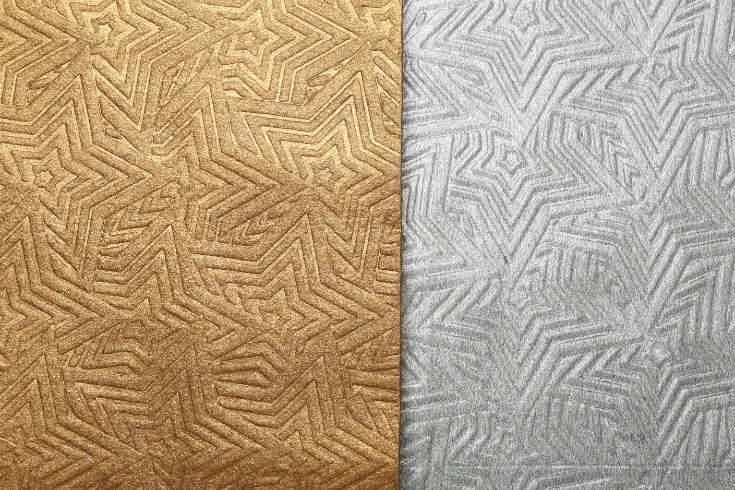
The craft of paper embossing involves creating a raised or three-dimensional pattern on paper. Crafters can use tools and molds to press or stamp designs onto paper, creating texture and dimension.
Projects you might like to try include wedding invitations with raised detail, business cards with embossed logos, decorative paper for scrapbooking, and book covers with raised motifs.
Paper Marbling
Paper marbling involves the technique of floating paint or ink on a liquid surface, usually a thickened water solution, and then transferring the swirled patterns onto a piece of paper. Every single marbled piece is unique, showcasing intricate veins and wavy designs. This craft is another that’s popular in schools as it’s simple to do, and the artist knows that their work is truly one of a kind.
You can use paper marbling to create marbled stationery or notepads, endpapers in classic books, wrapping paper and gift tags, and backgrounds for calligraphy pieces.
Paper Model
The craft of paper modeling or card modeling uses cut, folded, and glued paper to construct detailed three-dimensional replicas, from miniature architectural wonders to life-sized costumes or props.
This craft is popular for making scale models of famous landmarks, DIY toys or action figures, functional paper gadgets or mechanisms, and craft kits for children.
Papercutting
This ancient craft, found in various cultures, involves cutting out intricate designs from a single sheet of paper using sharp knives or scissors to create scenes, silhouettes, or patterns that play with positive and negative space.
Popular papercutting projects include silhouette portraits, Chinese New Year decorations, lacy wedding invitations, and framed artwork or window displays.
Papermaking
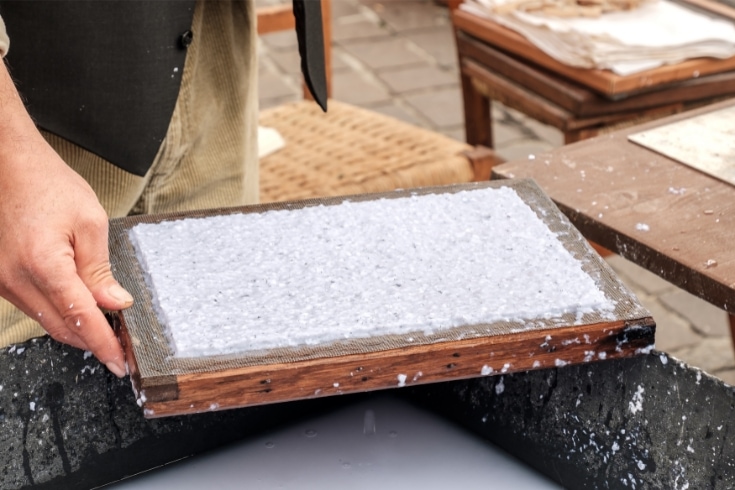
Papermaking is another popular school art crafting project that involves creating paper from pulp derived from plants, wood, or recycled paper. By changing the pulp’s texture, color, and additive, you can produce a vast array of handmade paper that can be used to create textured stationery with embedded flowers or leaves, hand-pressed paper for bookbinding, artistic sheets with varied opacities, and recycled paper crafts.
Papier-Mâche
Papier-mâche, which translates from the French words meaning “chewed paper,” is a crafting technique that uses strips or pulp of paper combined with glue or paste.
Once molded and dried, you can use your papier-mâche to create a solid structure that you can paint or decorate to make items like decorative masks or costume pieces, lightweight sculptures or statues, children’s craft projects like pinatas, and hollow containers or bowls.
Parchment Craft
Parchment craft uses special translucent paper, often embossed, perforated, and colored, to create delicate and intricate designs. The see-through quality of parchment paper adds depth and luminosity to your finished pieces that you can use to create spectacular luminous greeting cards, delicate bookmarks with detailed designs, window hangings or sun catchers, and even detailed lampshades.
Quilling
Quilling is also sometimes called “paper filigree” and involves rolling thin paper strips into various shapes and then gluing them onto a base to create intricate designs.
You can use the coiled paper to make detailed images, patterns, or even three-dimensional sculptures to create framed art with floral motifs, quilled jewelry like earrings or pendants, decorative boxes with raised patterns, and 3D quilled figures or ornaments.
Scrapbooking
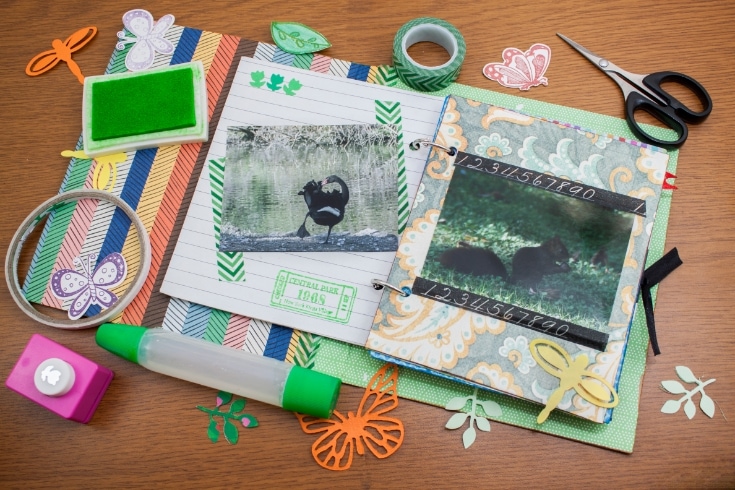
Scrapbooking is a way to curate and showcase memories, photos, and memorabilia in themed albums. Of course, you can add whatever embellishments you like to your creation, including ribbons, stickers, glitter, and the like, to build a detailed narration of your life story and bring it to life.
Popular scrapbooking projects include family history albums, travel adventure journals, baby’s first-year milestones, and event or celebration memory books. I have a scrapbook of my competitive horse riding years, and my OH has one with dozens of newspaper snippets of his time when he represented Great Britain as a yachtsman. It’s lovely to look back and relive our glory days over a glass of wine on a winter’s evening!
Paper Burning Art
Paper burning art is known as pyrography when it’s done using wood and involves using heated tools to scorch designs onto paper to create a rustic, etched appearance with varied tonalities based on the burn intensity.
You can use paper-burning art to build detailed landscapes or portraits, decorative patterns or mandalas, burned-edge greeting cards, stenciled or freehand designs on thick paper or cardstock, and the like.
Wood And Furniture Crafts
Wood and furniture crafts involve using various techniques, skills, and crafts to work with wood to create decorative items and home furnishings, turning simple timber into beautiful furniture and art.
Cabinet Making
Cabinet making is a highly specialized craft involving building furniture storage units. Masters in this craft have a sharp eye for detail and can produce intricate joinery that’s often bespoke.
Common cabinet-making creations include bookcases, entertainment centers, and kitchen cabinets that blend design and functionality seamlessly.
Carpentry
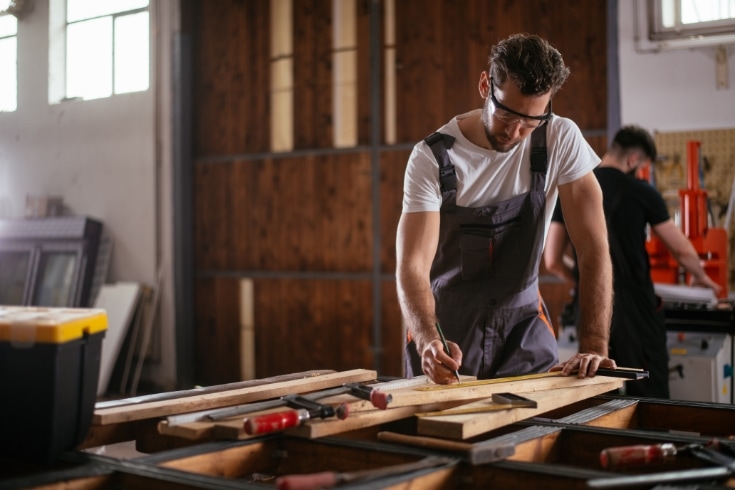
Carpentry sits between art and construction in that a good carpenter can build functional furniture, building frameworks, and detailed joinery, from the roof trusses of a home to a bespoke bookshelf.
Intarsia
The craft of intarsia is the intricate art of creating pictures or patterns from inlaid wood pieces of different sizes and shades to resemble a wooden jigsaw puzzle. Every piece of wood is individually cut, shaped, and fitted together, often resulting in breathtaking depictions of nature, geometric designs, or abstract patterns that you can use as wall art in your home or to present as gifts to friends and relatives.
Lacquer Art
This craft involves applying multiple layers of lacquer to create a decorative, protective surface for items like tables, trays, and coasters. Lacquer art is a meticulous process where every layer is polished to achieve a deep, mirror-like sheen with intricate designs and patterns.
Marquetry
Marquetry is a highly specialized craft that’s similar in many ways to Intarsia, focusing on veneer inlays to craft ornate, decorative designs. Marquetry uses different colored woods, shells, and other natural substances to create incredibly detailed scenes and patterns on luxury furniture, wall art, or even musical instruments.
Spoon Carving
With this craft, the clue is in the name! Spoon carving is a niche craft that involves transforming a simple wooden block into a decorative or functional spoon to emphasize the beautiful natural grain of the wood.
Timber Framing
The age-old tradition of timber framing involves creating large wooden structures without using nails or screws to hold the wood together. The timbers used are typically hefty and robust and are joined using wooden pegs in traditional techniques.
Timber framing is a highly specialist craft that’s often used to repair and maintain historic buildings, especially in Europe.
Upholstery
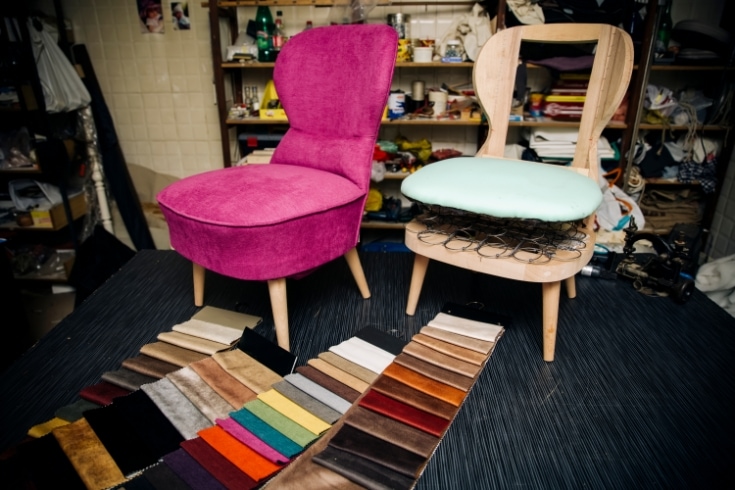
The craft of upholstery sees woodworking and fabric arts collide! This craft is all about giving comfortable padding and attractive covers to wooden-framed furniture.
Many crafters who are into upholstery seek out tatty pieces of furniture, such as chairs and sofas, at flea markets or online auction sites and buy them as restoration projects, either for personal use or to resell at a profit.
Wood Burning
Wood burning is also commonly known as pyrography and uses a heated tool to create images on pieces of wood to add character to everyday wooden items or create unique standalone art pieces. You’ll need a steady hand and somewhere safe to practice the craft of wood burning!
Wood Carving
As it sounds, wood carving involves creating carved designs on wood, such as intricate relief work on a wall panel to a three-dimensional statue. If you fancy trying this craft, you’ll need a suitable workshop, a keen eye, and a steady hand, as well as an understanding of wood’s grain and character.
Woodturning
In the craft of woodturning, the wood itself spins while the craftsman shapes it by using sharp tools in a dynamic process that creates symmetrical and round objects. Typical objects you can create include candlesticks, table legs, bowls, and even intricate pens, each showcasing the wood’s natural beauty.
Woodworking
Woodworking is an overarching term that embodies the myriad ways wood can be shaped, joined, and finished. From crafting a delicate jewelry box with dovetail joints to building a sturdy dining table, woodworking is the celebration of wood’s versatility, merging utility, durability, and beauty.
Metal Crafts
Metal crafting is where art meets metal, and functionality is blended with aesthetics. Whether it’s art pieces or everyday tools, this form of crafting is all about molding and shaping metal into something amazing!
Jewelry Making
At the heart of jewelry making is the art of turning metal, gemstones, and other materials into dazzling accessories you can wear or give as gifts to family and friends. Once you get into jewelry making, you could even launch your own small business, crafting unique pieces that aren’t available anywhere else!
Jewelry making involves using techniques like beading, setting, soldering, and more to create delicate gold necklaces with gem settings, chunky beaded bracelets, custom-designed engagement rings, and more.
Blacksmithing
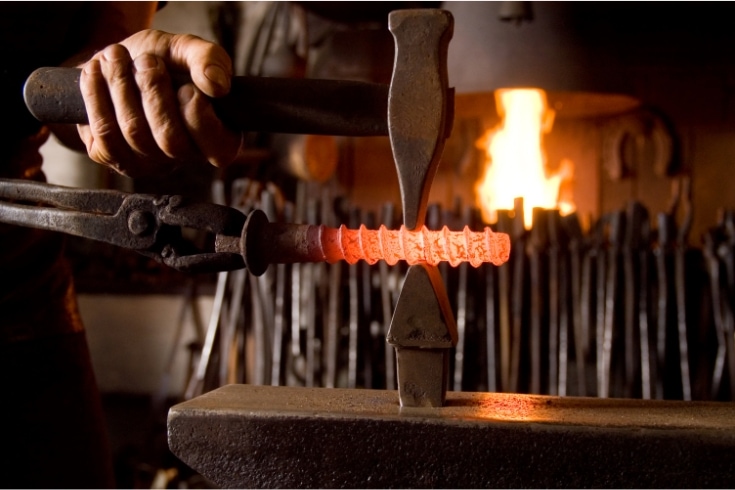
Don’t confuse blacksmithing with farriery! Blacksmithing is one of the oldest crafts, dating back to ancient civilizations, and involves taking raw metal, heating it in a forge, and then hammering it into shape to create something functional or decorative.
Examples of what you can make include intricate garden gates, fireplace tool sets, and even bespoke door handles.
Casting
The craft of casting sees artists melt metal and pour it into pre-designed molds, letting it cool and solidify into a desired shape. Casting allows you to create detailed and repeated patterns that can be used to make wonderful bronze statues, unique jewelry designs, and ornate metal tiles.
Clockmaking
Clockmaking, or horology, is the intricate art of designing and creating timepieces, blending precision engineering with aesthetic design.
Learning this craft takes many years of dedicated study, but once you’ve mastered it, you can restore and create grandfather clocks with carved details, modern wall clocks, and antique-style pocket watches.
Cloisonné
The craft of cloisonné is a decorative work that entails decorating metal surfaces with enamel divided by thin metal wires to create a stunning, colorful pattern. This is a very meticulous process that demands painstaking attention to detail and a steady hand, but once you’ve mastered the technique, you can make eye-catching pieces of jewelry, decorative bowls, ornate wall hangings, and more.
Coppersmith
A coppersmith is a skilled artisan who specializes in working with copper and other metals, Using traditional techniques like soldering, hammering, and brazing to join and shape pieces of copper together.
Typical items you can create using this skill include pots, pans, kettles, and other decorative pieces.
Enameling
Enameling is an ancient jewelry-making technique that is used today by modern jewelers to create colorful, unique designs. The process involves fusing microscopic glass particles with heat to create a solid layer of color onto a wide range of different metals, including sterling silver, copper, fine silver, and 18ct or 22ct gold.
As an enameler, you could make Vibrant brooches, decorative plates, earrings, and colorful pendant necklaces.
Farrier
Farriery is a profession rather than a craft that involves making and fitting horseshoes, and it takes several years of study before you are allowed to practice. Some farriers repurpose old horseshoes to create decorative items for homes and gardens.
Knife Making
This craft focuses on designing and creating knives for various purposes, from blades to handles; every part of the knife is meticulously crafted. If you specialize in knife making as your chosen craft, you could make kitchen knives with wooden handles, ornate ceremonial daggers, and multitool pocket knives.
Locksmithing
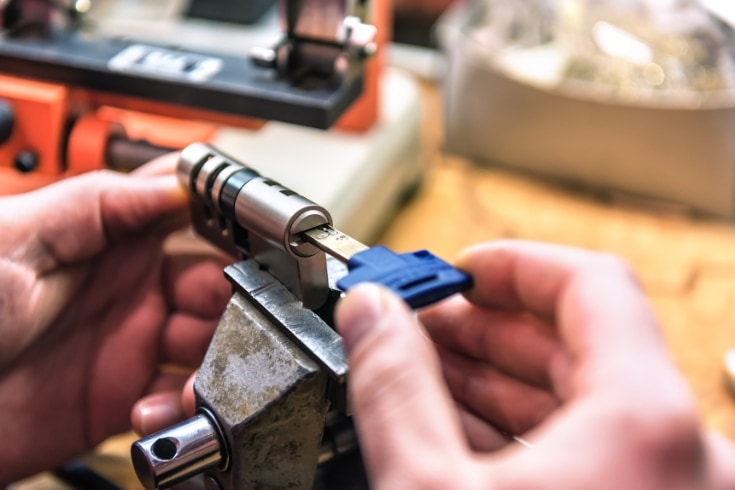
Locksmithing is about more than just making keys and helping folk who’ve locked themselves out of their homes! This craft is about creating systems that secure and protect, and skilled locksmiths can create both functional and decorative pieces like antique-inspired padlocks, decorative key designs, and advanced locking systems.
Metalworking – Metalsmith
The umbrella term of metalworking covers a vast range of techniques, from bending to welding. Metalsmiths, with their diverse skills, create both functional and decorative items, such as garden sculptures, metal furniture accents, and custom tool sets.
Pewter
Pewter crafting involves working with this soft, silver-gray metal that’s popular for its ease of use and elegant finish. As a pewter crafter, you could make decorative pitchers, engraved plates, vintage-style jewelry, and much more.
Metal Wire Art
Metal wire art is all about using metal wires of different colors and gauges to create three-dimensional sculptures or decorative pieces, often styled with intricate twists and turns, such as tree sculptures, earrings and necklaces, and decorative birdcages.
Silversmith
As you’ve probably guessed, silversmithing involves crafting objects out of silver! From decorative to utilitarian, the beautiful shimmering metal offers plenty of potential and is much less expensive than gold.
As well as jewelry, you could make handcrafted silver teapots, decorative trays, and sports trophies.
Tinware – Tinsmith
A tinsmith makes and repairs pieces out of sheets of tin or repurposed items such as old biscuit tins. Traditionally, tinsmiths made tin containers for kitchen and farmyard use, using the winter months to create their stock and then taking to the roads over the summer months to sell their wares.
If you decide to get into tinware making, you could create items including cups and plates, vintage-style lanterns, and decorative wall sconces.
Watchmaking
Rather like clock making, watchmaking goes beyond just time-telling and is where engineering meets artistry. Every tiny component in a watch is carefully designed and assembled, often taking months or even years to complete. Items you could repair or build from scratch include luxury wristwatches, intricately designed pocket watches, and avant-garde timepieces.
Weaponsmith – Sword Making, Armorer, Gunsmith, Fletching
The ancient craft of weaponsmithing encompasses creating a tremendous range of weapons for both decorative and functional purposes. Each specialization, from sword making to fletching, demands distinct skills and techniques To create hand-forged swords with highly detailed, protective suits of armor, handmade arrows, and custom firearms.
Leatherwork
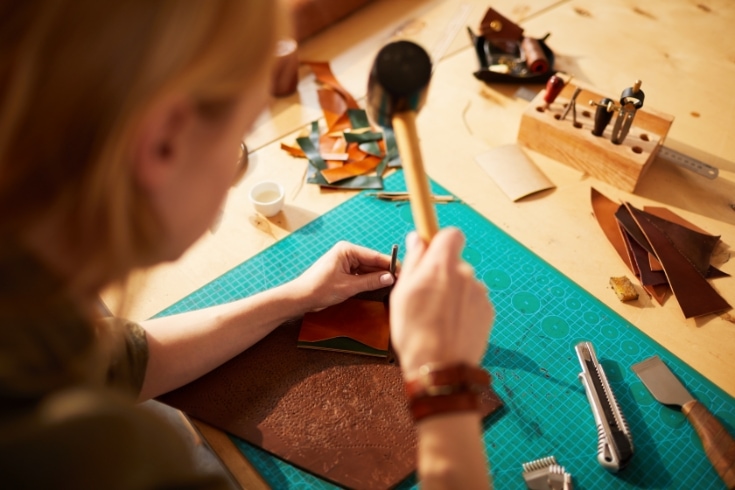
Leatherwork means making items using leather or tanned animal skin. There are several steps involved in taking the raw material to a finished piece, and the craft involves designing, cutting, and then a range of finishing processes, depending on the item being worked on.
Boiled Leather Making
Boiled leather is also known as cuir bouilli in French and refers to the process of boiling tanned animal hide to make it harder and stiffer. Once treated, the leather is more resistant to wear and tear and was historically used to make armor because of its durability and protection capabilities.
Today, boiled leather is used to make certain protective gear that needs to be flexible and rigid, and some artists use this material to create sculptures or other forms of rigid artwork.
Leather Carving
Leather carving is a decorative craft where patterns and designs are stamped or tooled into the surface of damp leather so that when the leather dries, the designs become permanent. Crafters use various tools like swivel knives, bevelers, and background tools to create intricate and detailed patterns on items like belts, wallets, purses, and book covers.
Leather Crafting
The art of leather crafting encompasses a broad range of activities where the crafter makes things from leather, potentially involving using various techniques like cutting, shaping, dyeing, stitching, and more. Leathercraft requires a set of specialized tools, such as cutters, mallets, awls, and needles to enable the crafter to decorate the leather with studs, rivets, or even gemstones.
You can make lots of things from leather, including belts, clothing, vests, handbags, and the like.
Flower Crafts
Flower crafts involve using natural and silk flowers to create decorative displays for use in the home and at weddings, funerals, birthday parties, christenings, and the like.
Bouquet
A bouquet is a collection of flowers (and sometimes herbs or other plants) that are arranged creatively. Bouquets are typically handheld and often given as gifts or used for special occasions, including weddings and birthdays.
For example, you could create a bouquet of a dozen red roses tied together with a satin ribbon for Valentine’s Day, a mixed bouquet of sunflowers, gerbera daisies, and lavender wrapped in burlap for a rustic gift, and a bridal bouquet composed of white orchids and baby’s breath for a wedding.
Floral Design
Floral design is a craft that involves artistically arranging flowers and other natural plant materials in a pleasing and balanced way. This craft encompasses a broad range of styles and is typically used for various events and spaces, from personal homes to big parties and balls.
Examples of floral design include a tall centerpiece for a wedding reception table, a circular wreath made of evergreens and berries for the winter holidays, and a floral archway made of roses and ivy for a garden wedding ceremony.
Ikebana
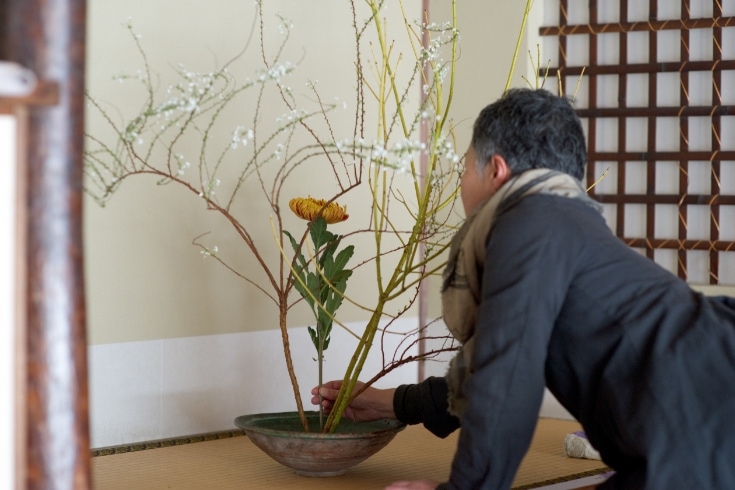
The craft of Ikebana is the Japanese art of flower arrangement, but there’s more to it than just arranging flowers!
This form of crafting is actually a disciplined art form where the arrangement you create is a living thing that emphasizes harmony, lines, and balance. Ikebana often incorporates not just floral blooms but includes stems, leaves, and other plant parts.
Examples of Ikebana can include minimalist arrangements with a single lily, its long stem, and a curled leaf, a three-tiered design that signifies heaven, human, and earth using chrysanthemums, bamboo, and ferns, and a modern asymmetrical composition using a branch of cherry blossoms placed alongside a tall vase.
Needlework
Needlework is a form of crafting that involves decorative sewing and textile arts handicrafts, including crochet, working with a hook, tatting, embroidery, and more.
Applique
Applique is a crafting technique that uses pieces of fabric that you overlay and stitch by hand or machine onto a larger piece of material to create a design.
Using applique, you can make decorative pillow covers, wall hangings, and detailed quilt designs.
Crochet
Crochet is a form of needlework that uses a hook to loop yarn or thread into intricate patterns and designs. There are lots of stitches to learn, like single, double, and treble crochet, that enable you to create a diverse range of patterns and textures.
Examples of things you can make using crochet include granny square afghans, crocheted lace tablecloths, baby booties, crochet bikinis, and filet crochet artworks.
Embroidery
Embroidery is a traditional craft that involves embellishing fabric using thread, yarn, or ribbon to create beautiful patterns and designs. You can learn hand techniques like cross-stitch, crewel, and blackwork, or “cheat” and buy a modern machine that can be programmed to produce detailed, complex designs automatically!
Crafters can use embroidery to create beautiful clothing, including hand-embroidered folk dresses, as well as wall hangings, embroidered monograms on linen, and machine-embroidered logos on baseball caps.
Knitting
Knitting is an immensely popular craft for both men and women that involves using two or more needles to turn yarn into cloth via a series of interconnected loops. You can use different stitches, such as knit, purl, and ribbing, to create a seemingly endless range of textures and patterns.
You can knit pretty much any piece of clothing (except perhaps underwear!), and popular examples include sweaters, shawls, beanies, baby blankets, socks, and mittens.
Nålebinding
Nålebinding originates from Denmark and literally means “binding with a needle.” This ancient technique was around before crochet and knitting and involves using a single, large-eyed needle to create fabric by passing the full length of the working yarn through a series of loops.
Using this strange craft, you can make Viking-era mittens and hats, Ancient Egyptian socks, and modern experimental clothing and accessories that are sure to make you stand out from the crowd.
Needlelace
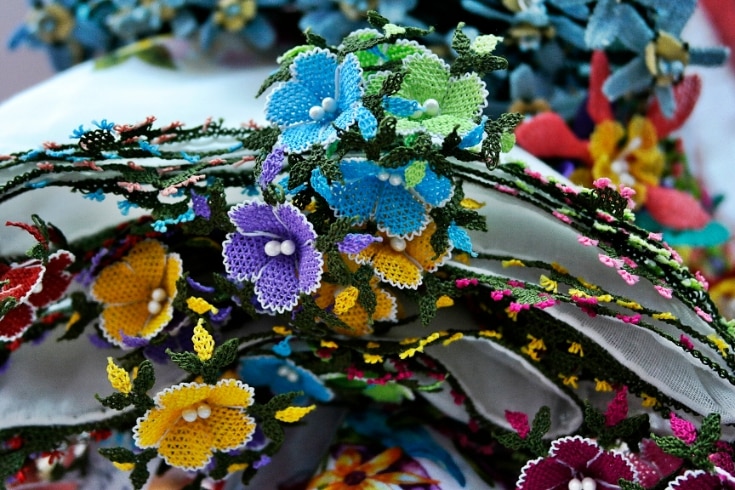
This craft is considered to be one of the most intricate forms of lacemaking. It uses a needle and thread to create delicate, web-like designs, often by creating a pattern on a sheet of paper and sewing directly onto it.
Examples of things you can make from needlelace include bridal veils, ornamental collars, intricate tablecloths, and decorative panels.
Patchwork
The ever-popular craft of patchwork is a great way of using up small pieces of leftover fabric from larger projects by stitching them into patterns or blocks to create quilts and modern geometric wall hangings.
Quilting
The craft of quilting involves combining a decorative top layer of fabric, insulating batting, and a backing layer to make a three-dimensional textile. You can stitch through all the layers to follow the Patchwork design or add an additional decorative element to your creation.
Aside from the obvious cozy cover to go over your bed, you can use this crafting technique to create elaborate stitched patterns and quilted vests.
Sewing
Sewing is one of the oldest textile crafts and involves joining pieces of fabric together using thread and a needle, either by hand or machine. You can sew whole garments, make repairs to damaged items of clothing, and add embellishments to brighten up something plain.
Examples of things you can sew include tailored suits, handmade dolls, fabric pouches, and decorative pillow covers. When I was a student, I didn’t have much money to spend on expensive designer outfits, so I used second-hand patterns I found in charity shops and cheap, end-of-roll fabrics to make my own clothes. I also made a small amount of pocket money by creating and selling curtains, soft furnishings, and smart satin-lined vests.
Spool Knitting
This form of knitting is often used as an introduction to the craft for children. This simple craft uses a spool with pegs or nails and a hook to create a knitted cord by looping yarn around the pegs.
As a child, I remember making simple necklaces and bracelets by spool knitting, and you can also create decorative trims for garments and coiled mats or coasters for use in your home.
Stone Crafts
As the name suggests, stone crafts are any form of crafting that uses stone. You’ll need a few specialist tools and a spacious, dedicated workshop if you want to get into most of these crafts, but the effort is worth it!
Flintknapping
The ancient art of flintknapping involves making tools and weapons from flint or other hard stones, typically by striking one stone with another stone or tool to flake off pieces, shaping the original stone into a desired form.
Examples of what you can make using flintknapping include arrowheads, spear points, and hand axes.
Letter Carving On Stone
As you might have guessed, the craft of letter carving on stone involves engraving letters or symbols onto a stone surface, typically using chisels and mallets to carve out each character carefully.
A few examples of letter carving on stone include gravestones, memorial plaques, and historical markers that often feature names, dates, and other inscriptions.
Mosaics And Inlaying
The crafts of mosaics and inlaying were especially popular during Roman times. Mosaic artworks are made by arranging small pieces of colored stone, tile, or glass to create a design or picture, while inlaying involves embedding pieces of material into a solid surface, like stone, to form patterns or pictures.
Some good examples of this form of crafting include Roman and Byzantine wall mosaics, depicting mythological scenes or everyday life, and modern inlays used on table tops or flooring to make intricate designs using different colored stones.
Stone Carving
The art of stone carving involves removing some material from a larger stone and using it to create a sculpture, ornament, or some other decorative item. This form of crafting can range from intricate, detailed work on ancient temples to creating massive statues, such as Michelangelo’s “David.”
Stonemasonry
Stone masonry is the highly skilled craft of shaping and assembling pieces of stone for construction purposes, typically cutting, shaping, and fitting stone blocks and slabs to build a structure.
For example, historical stone masons were involved in constructing bridges, walls, and cathedrals, such as the Pyramids of Giza and Notre-Dame in Paris.
Houseware
Houseware generally refers to anything you can use in your home, making this a very broad category!
Basket Weaving (Also Called Basketry, Basket Making)
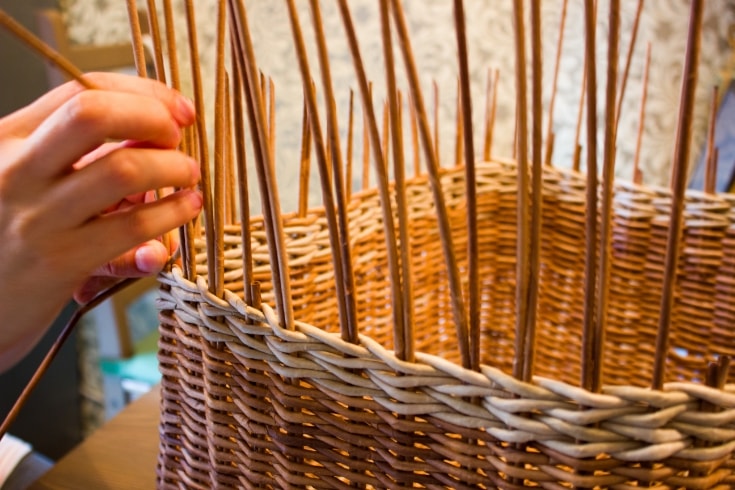
Basket weaving is the process of creating baskets using various flexible materials, typically willow, cane, reed, or grass. The crafter weaves their chosen material together in specific patterns to create baskets that can be functional and/or decorative.
Cooper
A cooper is a highly skilled craftsman who makes and repairs wooden barrels, casks, vats, tubs, buckets, and other similar containers from timber staves bound together with metal hoops. This form of crafting is known as coopering.
Fashion
The craft of fashion includes anything you wear, including clothing and jewelry. Crafters who are into this hobby typically study magazines for the latest high-fashion trends and try to copy them on a budget.
Cloth
Cloth crafting involves creating and decorating items using fabric or cloth. This craft covers a wide range of techniques, from sewing, embroidering, and quilting, to fabric painting, dyeing, and more, to create functional or decorative items to wear or for the home.
Quilting, embroidery, and fabric painting are all examples of cloth crafting.
Jewelry
Jewelry crafting, also known as jewelry making, involves making jewelry items using various materials and techniques. Crafters typically use metals, beads, gemstones, and other materials to make earrings, necklaces, bracelets, rings, and more, and popular techniques can range from beadwork to metal smithing.
Recycled Crafts
If you’re an eco-warrior and you care about the planet’s diminishing resources, you might want to get into recycled crafting. This form of crafting uses old, unwanted stuff that would otherwise finish up in landfill sites to give it a new lease of life.
Plastic Crafts
We’ve all seen how much plastic is produced and how much finishes up in the seas and litters the countryside, so taking up plastic crafts is a great way of repurposing plastic items that might otherwise end up in the trash. These crafts are both eco-friendly and innovative, turning waste materials into beautiful and functional items.
A few examples of plastic crafts include making plastic bottle planters, bottle cap mosaics, and weaving strips of plastic bags into mats, bags, or baskets.
Tin Cans
Although old tin cans can usually be recycled, they also make great crafting material for those with time to spare and a good imagination. Items you can make from old tin cans include tin can lanterns, desk organizers, wind chimes, and plant holders.
Nature Crafts
Nature crafts are another personal favorite of mine and involve using items I come across in nature, often during walks with my dog. These crafts celebrate the beauty of the natural world and often have a rustic or boho aesthetic.
A few examples of nature crafting projects you might like to try include shell jewelry, leaf press art, twig photo frames, and creating Christmas tree ornaments from fallen pinecones.
Other Types Of Crafts
These types of crafts don’t fit within any of the categories we’ve already covered above, so they’ve earned their own section in our guide. Of course, if you can think of any other random crafts we haven’t mentioned, please shout out in the comments box below!
Candle Making
As you might guess from its name, candle making is the craft of creating candles by melting and shaping wax or other materials. Nowadays, everyone seems to be into scented candles, so you can use your new crafting skills to make gifts for your friends and family or perhaps set up a small business to sell your creations.
Examples of popular candles you can make include pillar candles, votive candles, tea lights, scented candles, layered candles, and wax melts.
Resin Crafts
Resin crafts use a liquid resin that solidifies into a clear, glass-like finish when mixed with a hardening catalyst. You can use resin to preserve objects or create jewelry to wear and decorative pieces for use in your home or workplace.
For example, popular crafting projects include resin jewelry (pendants, rings, earrings), paperweights, resin-coated artwork or photographs, and table tops with embedded objects like flowers, shells, bottle tops, and foreign coins.
Soap Making
Soap making is another craft that’s perfect for you if you love giving gifts or you fancy starting your own business. The craft of producing soap, which is a saponification reaction between fats or oils and lye, allows you to personalize your creations by including scents, exfoliants, colors, and even flower petals.
Popular examples of this craft that you could make include bar soaps, liquid soaps, glycerin soaps, exfoliating scrubs, and decorative soaps shaped like flowers, animals, or other objects.
Beadwork
Beadwork is a popular craft with children and teens that involves attaching beads to one another or to pieces of cloth using a needle and thread. This craft is often used to make jewelry or to decorate clothing and household items such as cushions and drapes.
Shrinky Dink
The quirkily named Shrinky Dink is a craft that involves heating sheets of plastic till they shrink to a fraction of their former size, thickening, and hardening in the process.
Artists create striking designs on the sheets by coloring or drawing on them before heating them and making keychains, pins, jewelry, miniature artworks, and decorative tags.
Wirework
The beautiful craft of wirework involves creating jewelry, sculptures, or other decorative pieces using wire. The wire is twisted, bent, and wrapped to create amazingly intricate designs that are often unique to the crafter.
If you’re into jewelry, you can make pendants, bracelets, and rings for yourself and to give as gifts, or you could fashion things for your home, such as sculptures, candle holders, birdcages, and the like.
What Are The Benefits Of Crafting?
The benefits of crafting are many and varied, which is one of the reasons unleashing your creative side is so popular!
Hand-crafting something from scratch is extremely therapeutic and relaxing, especially if you can wear or use your creation around your home or present it as a gift to a friend or family member. There’s no doubting the sense of achievement you get when people admire your finished craft, and popular crafts like candle making and needlework can be a fun way to generate extra income.
In this part of our guide, we take a closer look at the benefits of crafting, so read on and prepare to be inspired!
Creativity And Self-Expression
Crafting is a great way to let your creativity flow, express your personal style, and communicate your emotions and thoughts through the medium of art.
Stress Reduction
When your life gets hectic and everything feels like it’s getting right on top of you, crafting can be a calming escape. Focusing on a challenging new project and learning a new skill can really help to take your mind off things, especially if you have something beautiful to show for your efforts.
Skill Development
Although crafting is about having fun, you’re also learning and honing a whole new skill set, which is especially important for helping young kids develop dexterity and brain power. I guess that’s why simple crafting activities are used so extensively in schools and kindergartens.
Sense Of Achievement
Nothing can compete with that ultimate satisfying feeling of accomplishment when your project is finished. In fact, you feel so good that you can’t wait to get started on your next piece!
Social Connection
In many cases, crafting can be a group thing. Whether you’re joining a local workshop or sharing pics of your work online with other crafters in your niche, it’s a fun way to connect with others and make new friends.
Sustainability
We all want to do our bit to help the planet, and certain forms of crafting can be very eco-friendly. For example, repurposing or upcycling unwanted materials into something you can use or wear feels great, saves your money, and could help to save the Earth, too!
Gift-Giving
Receiving a handmade gift tells you that the person giving it really cares about you. After all, look at the hours of time and effort they’ve spent on creating something, especially for you. And for the crafter, knowing you’ve put your heart and soul into your gift really does make you feel good, so it’s a win-win!
Brain Health
Crafting isn’t just hands-on; it’s brain-on too! Most crafts demand a certain degree of thought and planning, helping to keep your mind active and engaged, which is great for keeping boredom at bay if you’re retired or a full-time homemaker.
Cultural Preservation
Some crafts are like history lessons, carrying on traditions and stories from the past. For example, stonemasonry, lacemaking, watchmaking, and mosaics all date back many centuries, so specializing in one of those traditional crafts helps to preserve the culture of that time.
Income Generation
If you’re really good at your chosen craft, you could sell your creations online through a website and to friends and family. That’s a neat way to earn from what you love doing and could help to boost your income considerably.
Personalization
Although you might follow a pattern when knitting, crocheting, or dressmaking, any form of crafting means making something that’s uniquely yours. No off-the-shelf vibes here!
Time Management
In today’s busy world of work, home, and family commitments, it can be tricky to manage your time effectively. Balancing your beloved crafting projects with all those other tasks you must do can help improve your time-management skills, which in turn improves other areas of your life.
Hobby And Leisure
Beyond all its other undeniable benefits, crafting is just enjoyable and fun to do! Getting creative is a lovely way to spend some free time, so what are you waiting for?
How Do You Get Started With Crafting?
To get started, you’ll need to take some time to think about what you want to do, what time you have to spend on your chosen craft, and what space you have available in your home.
Keep reading to learn how to get started with crafting!
Choose Your Craft
The first thing you must do is choose your craft! That sounds simple enough, but as you’ve learned already, there are a lot of different crafts to consider. Some people are naturally artistic, whereas others prefer to be more hands-on, so think about what suits you and narrow down your decision from there.
Create A Dedicated Workspace
Some crafts use very specialist equipment, which can take up quite a lot of space. For example, if you want to get into cabinet making or some kind of metalwork, you will probably need a large workshop. However, crafts like jewelry making and beading can be done on your dining table or in your home office.
So, the next thing you must do is ensure you have enough room in your home to accommodate your chosen craft without causing any domestic strife!
Join A Crafting Community
I wholeheartedly recommend joining a crafting community either online or a local club if there’s one near where you live. Learning a new skill can be quite daunting, and having a ready pool of enthusiasts to pick up tips from is invaluable.
Gather Basic Supplies
Having decided on the craft you want to take up and set aside a designated crafting zone in your home, you’ll need to gather the basic supplies you’re going to need to get started.
Depending on the craft you’ve chosen, you can typically find the necessary supplies online. However, new friends in your crafting community will soon point you in the right direction when it comes to buying supplies.
Learn The Basics
You’ll find it much easier and quicker to make progress if you master the basic techniques of your chosen craft first. In other words, don’t try to run before you can walk!
Start With Simple Projects
In a similar vein, you should start with simple projects rather than taking on complex, technically demanding ones. They say that success breeds success, and that’s certainly true when it comes to learning a new skill in any field.
Starting with something easy pretty much ensures success, boosting your confidence and inspiring you to take on something more challenging next time.
Practice Regularly
Practice makes perfect in most aspects of life, and crafting is no different. So, try to spend some time learning about your new hobby. Ideally, you want to hone your skills by working on a project daily, but if that’s impossible, you should at least try to read and research your craft online.
Explore New Techniques
As you build your skills, you can start to check out new techniques and ways of improving your results. Again, the folks in your crafting community will be happy to show you different ways of doing things and introduce you to what’s new in the marketplace for your particular craft niche.
Seek Inspiration
As you gain confidence and your skills develop, you can read magazines, do some evening online surfing, and watch YouTube videos to find inspiration for new projects.
Share Your Creations
Once you have a portfolio of creations, you can share them with other crafters, your family, and friends. Depending on their reaction, you might even decide to start selling your crafts to generate income from something you love to do!
Be Patient And Enjoy The Process
Don’t pressure yourself to master your chosen craft in record time! Learning any new skill takes time, so be patient and enjoy your journey.
FAQs
In this part of our guide, we answer some of the most commonly asked questions by people who are wondering what crafting is and whether it’s a good hobby for them.
What Are Some Popular DIY Craft Projects For Beginners?
Some popular DIY craft projects for beginners include:
- Knitting
- Crochet
- Decoupage
- Beading
- Recycling and upcycling crafts
- Paper crafting
These crafts are easy to learn and relatively inexpensive to do, making them ideal if you’re not sure what kind of crafting activity suits you the best.
What Are The Difference Between Traditional And Digital Crafting?
Traditional crafting uses physical materials like paper, wood, fabric, metal, and beads to create tangible items like jewelry, pottery ornaments, crockery, and greeting cards. This form of crafting is generally hands-on and very tactile.
In contrast, digital crafting involves using digital tools and software to design and create. For example, graphic design, digital art, and 3D modeling. These crafts can be virtual, or they can be translated into physical forms using machines like 3D printers.
Are There Any Eco-Friendly Crafting Options Available?
Yes, there are plenty of eco-friendly crafting options to choose from.
Many crafters like to use recycled or upcycled materials to turn old home items found in their attic or garage into new creations. Alternatively, you could while away an afternoon or two searching thrift stores and charity shops for old stuff to repurpose.
Some crafters go eco by choosing sustainable, organic, or biodegradable materials like bamboo yarn or organic fabrics to work with and use natural dyes derived from plants. They avoid single-use plastics and opt for natural or recycled alternatives instead.
Are There Any Crafts That Combine Multiple Disciplines?
Yes, there are a few crafts that incorporate multiple disciplines. For example, mixed-media art uses various artistic mediums together, like paint, ink, and collage, while quilting can combine sewing with painting or printing on fabric, and bookbinding might combine paper crafting with leatherwork or woodworking.
Are There Any Culturally Specific Crafts?
Almost every culture has unique crafts rooted in its history, traditions, and environment.
For example, Kintsugi is the Japanese art of repairing broken pottery with gold, tatting is a form of vintage lace-making, and Māori flax weaving or “raranga” from New Zealand uses flax stems to create traditional items.
What Is The Definition Of A Craft?
A craft can be defined as a skill or trade that involves designing and creating something by hand. Crafting encompasses a vast range of activities, from pottery and weaving to knitting and woodcarving, and is often characterized by its emphasis on manual skill, creativity, and attention to detail. Many crafts have their roots in ancient history and are intrinsically linked to specific cultures, rituals, and traditions.
Conclusion
As you can see from our guide, there are myriad types of crafts that you can take up! You can unleash your inner artist and take up drawing, painting, or creating intricate paper sculptures, or perhaps you’d prefer to get hands-on, designing and making beautiful jewelry or crockery for use in your home. You could even build and upholster a whole new set of furniture for your living room!
The key to success is to start with something easy, join a community of fellow enthusiasts, and gradually build and develop your skills. Learn as much as you can from books, online videos, and informative websites before you dive in.
Once you get started, you can enjoy the feeling of achievement that comes with successfully completing a new project, and your stress levels will drop to an all-time low! What are you waiting for?

